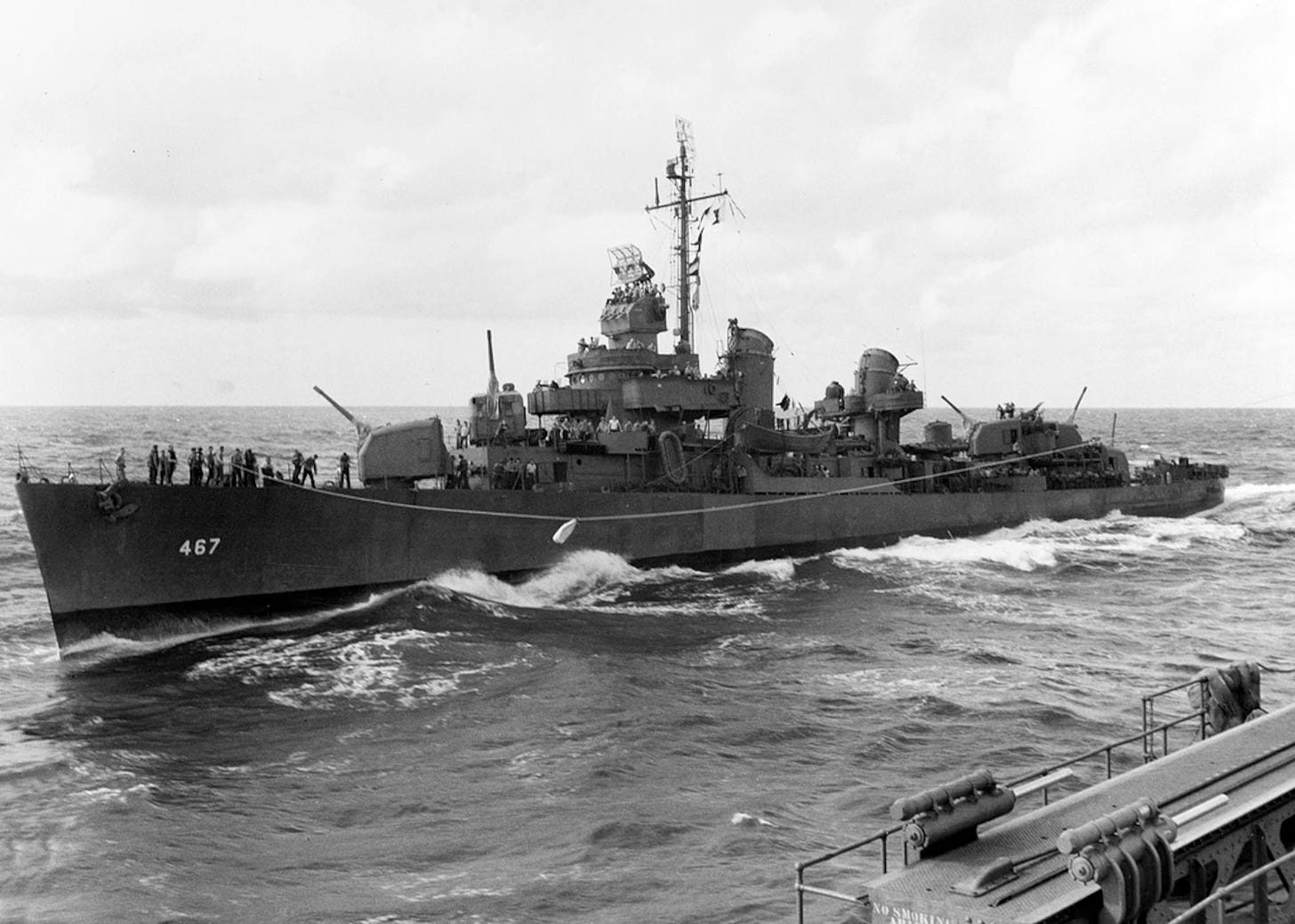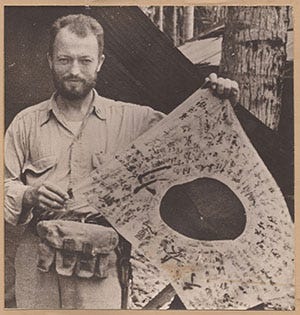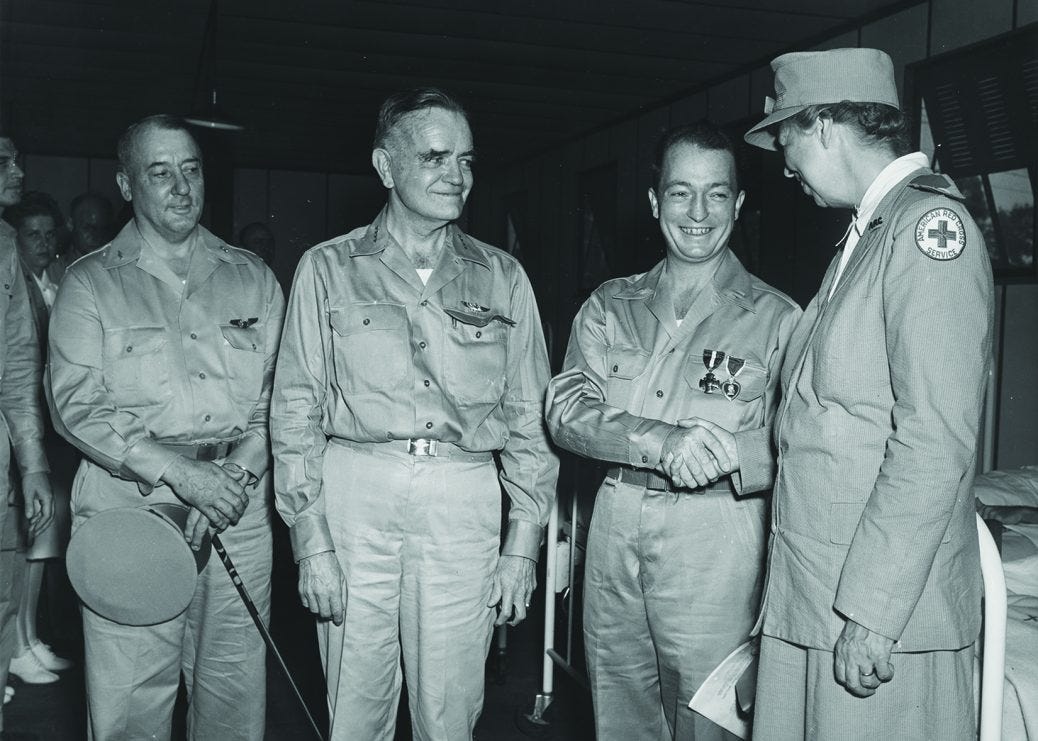How many times have you heard the advice to never quit? Don’t stop. Give your last measure.
Ship. Shipmate. Self - what does that mean?
We are surrounded by examples and benchmarks to measure yourself by.
It is never an easy thing – almost bittersweet - to reach at an early age an achievement of a lifetime while everyone around you suffers.
It’s 1931 and the nation is groaning under the Great Depression from coast to coast and yet there you are, a 140-lb 21-yr old man as quarterback for the University of Alabama in the Rose Bowl – blowing out Washington State in a 24-0 victory.
Where does life take you from there?
A little more than a decade later and at 31 – no longer a young man by the standards of the day – you find your nation moving from an economic depression in to a world war - a war that pulls you in.
A natural leader, you’re brought in to an officer program in the US Navy and by 1943 find yourself, Lieutenant Hugh B. Miller, on the newly commissioned Fletcher Class destroyer, USS STRONG DD 467.
After a little time in the Atlantic, off to the heart of the Navy’s war you go – to the Pacific;
On the night of 12–13 May, Strong and the task force bombarded Kolombangara, then commenced escort and patrol duty off Guadalcanal. On the afternoon of 16 June, she was halfway between Guadalcanal and Tulagi when a flight of approximately 15 Japanese dive bombers attacked the American ships. Strong was the closest ship to the bombers as they approached in a shallow dive and she claimed three shot down.
On the morning of 5 July, American forces landed at Rice Anchorage. Strong and TF 18 were to support the landings by shelling Vila-Stanmore, Enogai, and Bairoko. Strong and Nicholas entered Bairoko Harbor to search ahead of the main force and shelled the harbour from 00:30 to 00:40. Nine minutes later, a torpedo hit her port side. The torpedo was from a salvo fired by the Japanese destroyer Niizuki, from a distance of 11 nautical miles (20 km; 13 mi) and is believed to be the longest-range torpedo kill in history. Chevalier intentionally rammed Strong's bow to enable her to throw nets and lines to the stricken ship, and rescued 241 men. Japanese gunners on Enogai beach spotted the ships, illuminated them with star shells, and opened fire with high explosive rounds. O'Bannon began a counter-battery fire at the enemy guns that were hitting Strong and Chevalier who were forced to withdraw.
Strong began to settle rapidly with a 40° to 60° list to starboard, she broke in half just prior to sinking and several of her depth charges exploded. Forty-six men were killed and she was struck from the Navy list on 15 July 1943.
Well, Miller was not one of the 241 rescued, but neither was he one of the 46 of his Shipmates killed – fate had different plans. Via U.S. Veteran’s Magazine;
Miller, who was working to disentangle a few Sailors from netting on the Strong’s deck was unable to get to the Chevalier before they withdrew, and slipped unharmed into the water. He was not so fortunate once the Strong’s armed depth charges exploded. He incurred significant internal injuries.
He awoke on a float net with a small number of Sailors. He drifted in and out of consciousness for days, until their group landed on Arundel Island. Once marooned there, it became clear his condition was hindering the group’s options. He ordered the three surviving Sailors to leave him and seek refuge and rescue. Given his grave condition, he even provided his boots to one of them.
Armed Japanese squads were patrolling the island, and despite his injuries and days of malnutrition and dehydration, he was able to evade being discovered. He assumed he would succumb to his injuries, but he fought to survive. At one point, while hidden, he watched as one Japanese soldier stepped directly over his position. As his luck held out and his physical condition stabilized, his hopelessness began to ebb.
Want to hear more stories of heroism as a result of Strong’s sinking? Read, “Strong Crew and Rescue Set Sailor Standards for Initiative and Toughness,” here.
Fortune smiled on him again when the body of a dead Japanese soldier washed ashore. Miller recovered a grenade, bayonet and even some moldy but edible rice. He put each to good use. He ate coconuts to sustain himself. During a rainstorm, he was able to retain water in a small tin he possessed.
As the days wore on, his health actually improved, and he was emboldened with a rejuvenated determination. Using guerilla warfare tactics, he waged a one-man war against the enemy. In the next few weeks, he killed as many as 15 Japanese according to accounts, using captured bayonets and grenades. He attacked three Japanese machine gun nests. Some of his remarkable success throwing grenades might be attributed to his University of Alabama quarterback experience. His younger days spent outdoors in Mississippi as a tireless sportsman clearly proved vital in evading capture and surviving in the elements – injuries notwithstanding.
After 39 days on the island, he was finally re-united with U.S. forces and provided important intelligence regarding Japanese positions on the island.
Miller was awarded the Navy Cross, personally bestowed on him by Eleanor Roosevelt who was on a Pacific swing with the American Red Cross.
For his war service he was awarded the Navy Cross, two Silver Stars, six Bronze Stars, two Purple Hearts, and 27 other individual and unit decorations. He retired as a Navy Captain before passing away in 1978.
"The President of the United States of America takes pleasure in presenting the Navy Cross to Lieutenant Hugh Barr Miller, Jr., United States Naval Reserve, for extraordinary heroism and distinguished service in the line of his profession while serving on board the Destroyer U.S.S. STRONG (DD-467), in action against enemy Japanese forces in the Kula Gulf on 4 - 5 July 1943. Thrown into the water following the sinking of his vessel, Lieutenant Miller extricated two comrades who were entangled in a line on the ship's side and held them above water until he could place them in a net. He took charge of a group of survivors who finally reached a small island. Unwilling to allow his weakened condition to retard their progress, he ordered them ahead and remained behind to wage a lone battle against enemy units. Menaced constantly by hostile scouting companies, he maintained himself for 39 days until rescued by a friendly airplane. The conduct of Lieutenant Miller throughout this action reflects great credit upon himself, and was in keeping with the highest traditions of the United States Naval Service."
Of note, they found the wreckage of STRONG in 2019 and there is a 2016 book on his story, The Castaway's War: One Man's Battle against Imperial Japan.
In 1958, Miller was the subject of an episode of, “This is Your Life” hosted by … Ronald Reagan.
Fullbore.
h/t Gray







You have a great talent for finding inspiring history and keeping it alive. Thanks for this!
Why is the no USS Hugh Barr Miller?